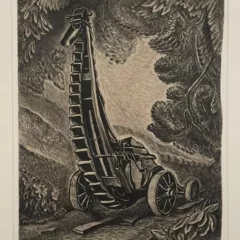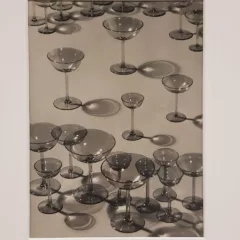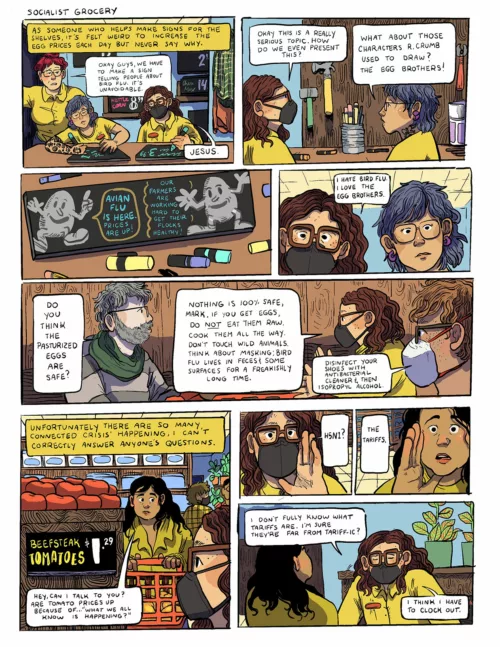Created with Admarket’s flickrSLiDR.
At the William Kentridge talk and opening of his Tapestries exhibit at the PMA. Here’s the Flickr photo set if you want to spend time and see them bigger.
A chance to hear William Kentridge at the Philadelphia Museum of Art and to get an early look at the exhibition William Kentridge: Tapestries attracted a whole clacque of admirers of the South African artist, including us.
The exhibit is the fourth in the Notations series on contemporary (and global) art, curated by Carlos Basualdo, to show off some of the PMA’s contemporary art holdings. Among the Kentridge work on display is Office Love, an enormous and romantic/ironic tapestry newly purchased by the museum. The piece talks to the Duchamp The Bride Stripped Bare by Her Bachelors, Even (The Large Glass), also at the PMA, but it’s more accessible. William Kentridge: Tapestries is the first one-man show in the Notations.
The exhibit also includes some sculptures, looking very existential and elegantly displayed atop metal “furniture” that transforms the hallway display into a drawing room. Collage/drawings related to the tapestries also are on display. And the whole exhibit is just great–giving a sense of a world in flux with migrations and upheavals. The dark figures are shadow cast against maps, puppets on a stage not of their choosing.
Anyway, take a look at the pictures and you can get a sense of what’s there. But then you’ll have to go in person to get a sense of the mappiness of the tapestries and the rough fiber from which they are made–not to mention the subtleties of their colors.
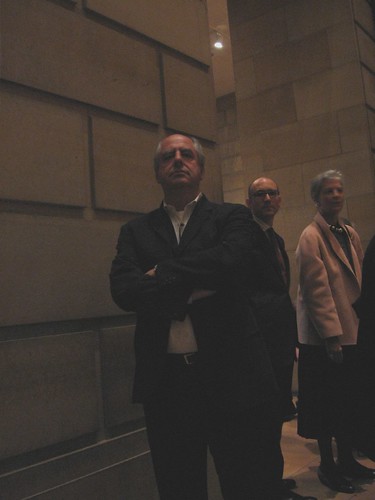
Kentridge, before his talk, with Carlos Basualdo and Anne d’Harnoncourt behind.
I had heard Kentridge speak before at a talk with modern art Curator Michael Taylor, also sponsored by Dina and Jerry Wind (who were there, of course). But this time, the conversation, which was with poet philosopher Susan Stewart, focused a wee bit too much on her interest in his process and on her interest in her own ideas. Kentridge said he wasn’t thinking of Ovid, and honestly, Stewart needed to let the Transformations go and find another tack. I wanted to hear more of the history that set his mind a-spinning–and more of the spinning.
Perhaps my complaining about too much focus on process is a bit unfair. Ultimately, I found how things were made quite interesting. Kentridge ripped pieces of black paper and then assembled them, moving them until he created forms of people that seemed right to his eye. The forms are like shadow puppets, the limbs, the posture, all articulate until set in place.
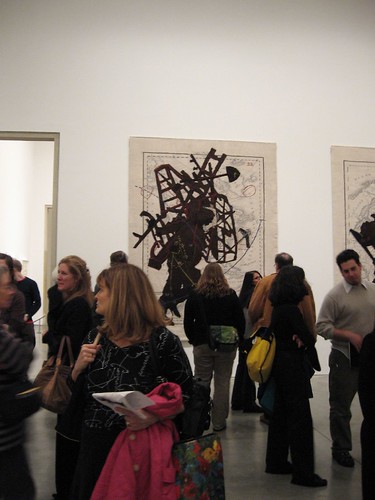
The tapestries were made by Marguerite Stephens and her Johannesburg-based Stephens Tapestry Studio, and the idea to create tapestries with his work was proposed by Stephens to Kentridge. The process of weaving sounded like an artistic endeavor of its own, with multiple judgment-calls required of the weavers, and with multiple weavers working side by side on each tapestry. During the weaving, Kentridge’s scaled-up work stood behind the loom, a bit back, so a shift in a weaver’s head position might create a different product, a different sense of where the edges of things were.
And the maps, which come from old books, are not from books that anyone might want to preserve, Kentridge assured his audience of book huggers. (I could hear the relief spread up the grand stair case when he said that). Kentridge was less interested in the specific places the maps depicted and more interested in maps as a metaphor for any place. He picked them based solely on their looks, he said. The maps Kentridge used in his original plans required revisions to accommodate the scale of the tapestries and the roughness of the yarns.

A related piece, using old book pages as a backdrop for the migratory figures
I know we talked to Hiro Sakaguchi, who helped hang them, but I’m not sure who else added to this bit of info: the tapestries are not completely stable, so they required a hanging system (clamps plus Velcro) more precise than Velcro alone could provide.
In short, everything–the lives of people, the maps, the creation of the tapestries, the tapestries themselves–all hinge on judgments and all stand on shaky ground. Ain’t that the truth?



